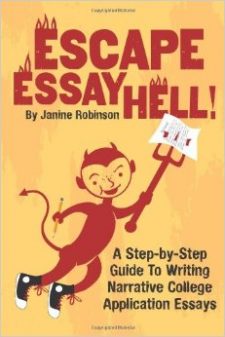
So you have a rough draft for one of your college essays.
You answered the prompt, read it many times and believe it’s a solid piece of writing.
And you may be right.
But even a solid essay can have one fatal flaw–-it’s boring.
The last thing you want is for the admissions person to toss your well-written essay in the “read later” pile. Here are a couple tips on how to bump it up:
1: Your introduction is the most important part of the essay, since it will either grab the reader or not.
Often, writers start by providing background on their topic and then get to the good stuff. Try to take out the first sentence, or two, and see if you can start farther into your story.
You might have to rewrite it a bit, but often you just don’t need that general background right at the beginning.
It’s best to switch it up and get right to your best example or point, and then provide the background later. If you can start with your most interesting examples or points, you will grab your reader all the faster, and that’s exactly what you want.
EXAMPLE: “When I was in high school, I played the violin in the school band. It was my favorite activity and I never missed a practice or performance. But one day, to my horror, I left my thousand-dollar violin on the school bus…”
You are building up to something exciting here. Try to start right at the heart of the action, the moment you left the violin and your reaction: “As I stepped off the bus, I had the vague feeling I was missing something.
But I was late for my orthodontist appointment, and ran to meet my friends. It was only later that night that it hit me: I left my thousand-dollar violin under the seat.” (And then you can go on to background your history playing the violin, etc.)
2: Once you have your reader’s attention, you want to keep it. Again, if you find yourself making broad, sweeping generalizations or points, make sure to follow them up with specific examples. What does specific mean? Details!
EXAMPLE: You say something like: “When faced with a challenge, I always approach it directly and try to find ways to turn it into something positive…”
That’s great. But this could easily get boring to read. So follow up with an example or two.
“When I broke my leg and couldn’t play tennis last season, I took up ping pong and started a tournament at my school.”
What you are doing is proving the general point you are making with examples. So whenever your make a point, or analyze something, or reflect upon an idea, or explain what something means, follow it up with examples.
3. The best way to “make copy sing,” as they say in the newspaper biz, is to be specific. Go through your essay and look for places where you can provide “concrete details.” Don’t just say I was in the school play; say “I played Puck in Midsummer’s Night Dream.”
EXAMPLE: “My dog ran down the street and nearly got hit by a big truck.” With concrete details: “My 2-year-old Standard Poodle ran down the street and nearly got hit by a vintage VW camper van.”
4. Check for too many adjectives.
EXAMPLE: “I love the way the old historic, bustling city looked at night.” Instead, work on giving examples/specifics/details of how the city looked at night. The lights in the skyscrapers glowed and long lines of red taillights wound around the city blocks.
5. Work on your verbs! A strong verb can make a sentence.
EXAMPLE: “When I fell into the rushing river, my dad pulled me back into the boat.” “When I fell into the rushing river, my dad grabbed my collar and hauled me into the boat.”
You don’t have to over do it, but see if there’s a more powerful verb, especially if you have a lot of “am, was, were, is, do, does, would be, etc.”







you have been a great help!!!